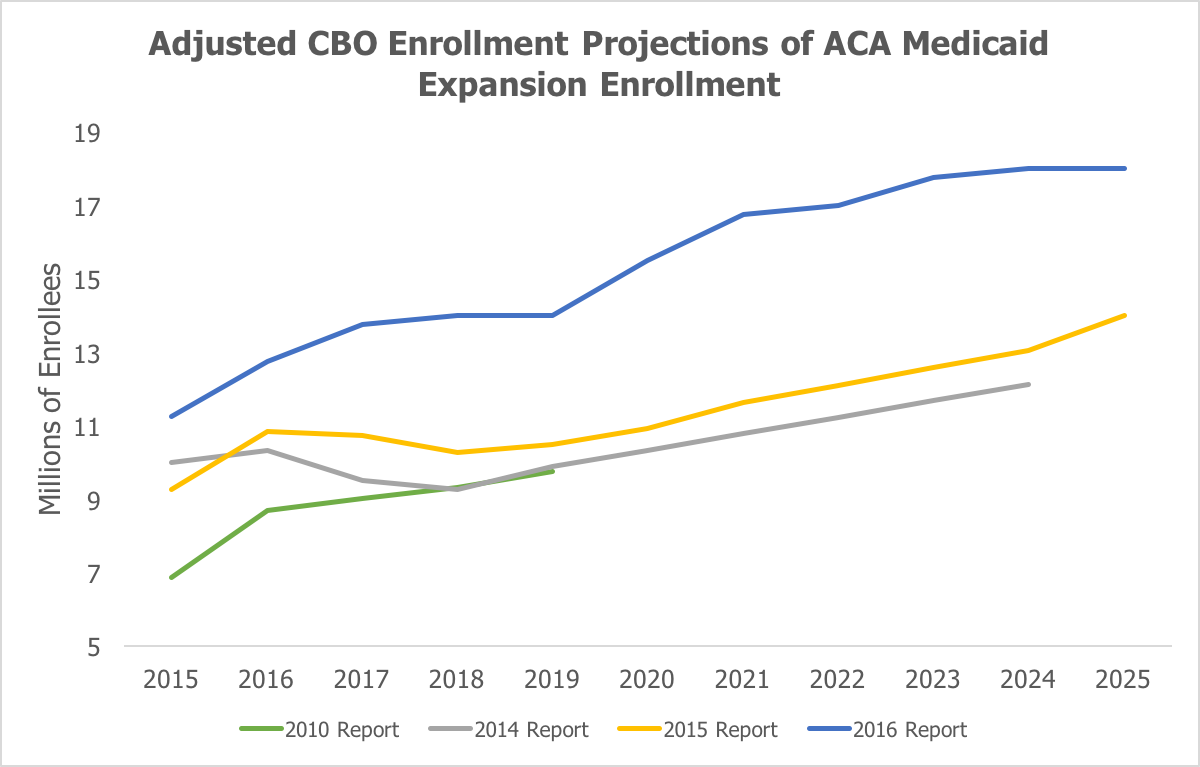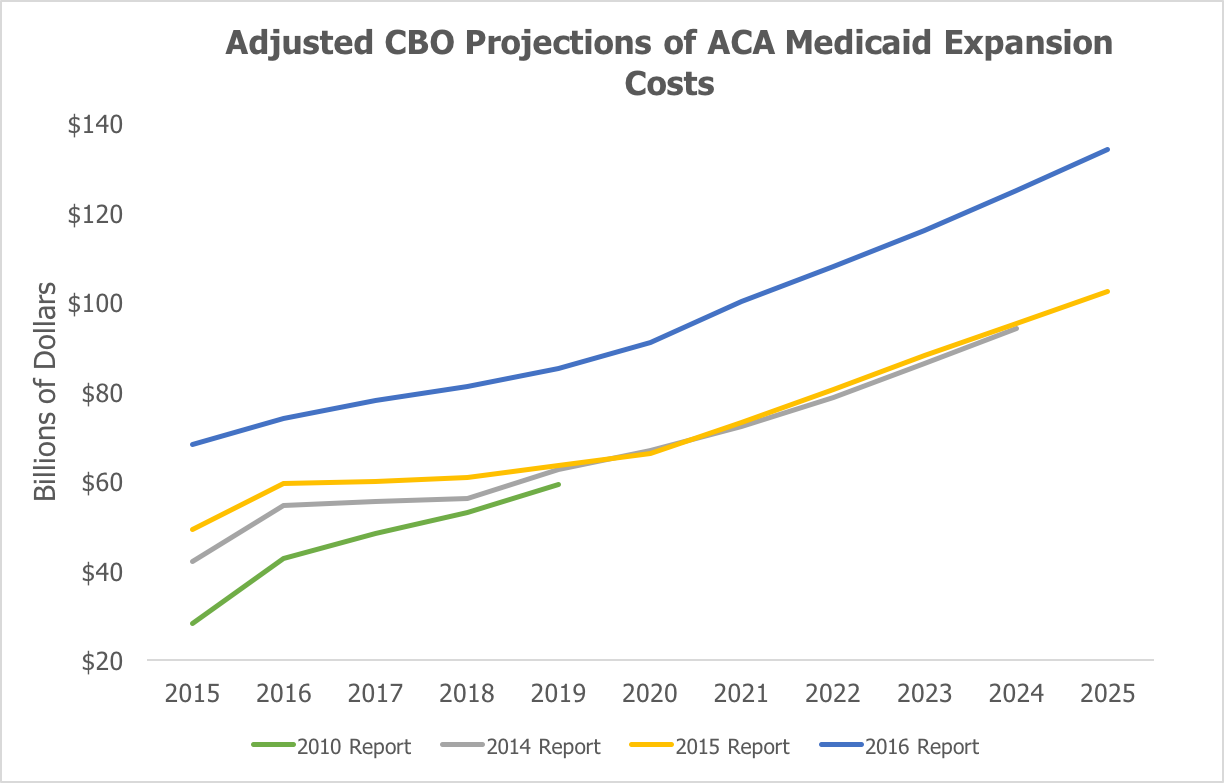"In new
research
published by the Mercatus Center, I analyze the causes and impact of
the much higher-than-expected enrollment and spending associated with
the Affordable Care Act (ACA) Medicaid expansion. Though unpredicted by
Washington experts, the results were predictable. The federal
government’s 100% financing of state spending on expansion enrollees has
led states to boost enrollment and create high payment rates. (See this
2-minute Mercatus
video for additional information on this significant development.)
In states that have expanded, enrollment and per enrollee spending
are nearly 50% higher than predicted. While interest groups within the
states—particularly hospitals and insurers—benefit from the higher
spending being charged to federal taxpayers, substantial evidence
suggests much of this new spending is wasted or provides little value
for its intended recipients.
An important 2015
study
showed that
Medicaid expansion enrollees obtain low value through the
program. Moreover, an increasing amount of spending on the program is
lost to waste, fraud, and abuse. The
Wall Street Journal highlighted
a new government report showing that
improper Medicaid spending
exploded between 2013 and 2016. Improper payments amounted to about $67
billion in 2016, a $41 billion increase from the estimated $26 billion
in 2013. The large increase in improper Medicaid payments has occurred
while the ACA Medicaid expansion took effect, suggesting that the
expansion is the main cause of the stunning rise. (Interestingly, the
Department of Health and Human Services has pulled the report from the
Internet.)
Perverse Incentives Produce Lots of Waste
Under the ACA, the federal government reimburses 100% of state
spending on expansion enrollees—non-disabled, working-age adults with
income between the state’s previous eligibility thresholds and 138% of
the federal poverty level ($16,394 in 2016). After this year, the
federal share gradually phases down until 2020 when it reaches 90%,
where it is scheduled to remain.
Common sense suggests that a jurisdiction is more likely to increase
spending on an area when the costs can largely be passed to other
jurisdictions. This type of financing structure also lessens a
jurisdiction’s incentive to ensure that the spending provides high value
with low amounts of waste.
ACA Medicaid Explosion
Medicaid, already on an unsustainable cost-growth trajectory before
the ACA, has experienced unprecedented enrollment and spending growth
since 2013.
Medicaid spending in 2015 was nearly $100 billion above the 2013 amount.
Medicaid expansion enrollment and spending is higher than projected
even though not as many states as expected have adopted the expansion.
My
research
shows the difference in the Congressional Budget Office’s (CBO)
Medicaid expansion enrollment and spending projections over time. The
first figure shows CBO’s most recent estimate of expansion enrollment
along with CBO’s estimates from 2010, 2014, and 2015.

Enrollment is much higher than CBO expected when the ACA passed in
2010, and it is also significantly higher, particularly in 2017 and
beyond, than estimated in both CBO’s 2014 and 2015 reports.
Essentially,
this means that far more people—roughly 50% more—have enrolled and are
projected to enroll in Medicaid in the states that expanded than was
expected by CBO previously. In addition to higher-than-expected enrollment, spending per newly
eligible Medicaid enrollee is much greater than expected. As I
wrote in July when the Obama administration released the
2015 Medicaid actuarial report,
government spending on newly eligible enrollees equaled about $6,366 in
2015—an amount 49% higher than its projection of $4,281 from just one
year earlier.
Both higher-than-expected enrollment and spending per enrollee has
resulted in the Medicaid expansion being much more costly than
projected. For example,
in April 2014, CBO projected that the Medicaid expansion would cost $42 billion in 2015. The actual cost was $68 billion, about 62% higher.
The second figure shows CBO’s projections of federal spending on the
Medicaid expansion and how CBO’s most recent projection of the cost are
substantially above previous expectations.
 Using
CBO’s current projections of state adoption of the expansion for its
previous estimates shows that federal Medicaid spending between 2016 and
2024 is $232 billion in excess of its April 2014 estimates.
Using
CBO’s current projections of state adoption of the expansion for its
previous estimates shows that federal Medicaid spending between 2016 and
2024 is $232 billion in excess of its April 2014 estimates.
Both figures adjust CBO’s previous year estimates for its current
assumptions about state adoption of the expansion. CBO now expects
states to adopt the expansion at a slower rate than it has previously
projected. In 2010, before the Supreme Court made Medicaid expansion
optional for states, CBO expected all states would adopt the expansion.
This adjustment allows for a better comparison of enrollment and
spending because it holds constant CBO’s assumptions about the
percentage of the newly eligible Medicaid population residing in
expansionary states.
Too Little Value from Medicaid Expansion
Prior to the ACA, when states shouldered their traditional share of
Medicaid spending (an average of 43%), only Vermont and the District of
Columbia
concluded
that the tradeoffs—higher state taxes and reduced spending
elsewhere—justified expanding Medicaid to the ACA expansion population.
It turns out that states that did not expand Medicaid prior to the ACA
almost certainly made a wise cost-benefit calculation.
A 2015
study from
economists at Harvard, MIT, and Dartmouth, assessing an earlier Medicaid
expansion in Oregon to a similar population to the ACA expansion, found
that
“[a]cross a variety of alternative specifications … Medicaid’s
value to recipients is lower than the government’s costs of the program,
and usually substantially below.” They estimated that the “welfare
benefit to recipients from Medicaid per dollar of government spending
range from about $0.2 to $0.4.” Oregon Medicaid expansion enrollees did not have significant improvements in blood pressure, cholesterol, or blood sugar relative to people who did not enroll in Medicaid.
Reform Medicaid, Stop Viewing Program as Economic Stimulus
In order to increase the value that enrollees receive from Medicaid
and lessen the amount lost to waste, fraud, and abuse, it is necessary
to change the central incentives underlying the federal-state
partnership. In particular, the incentives of the ACA’s elevated
reimbursement rate lead policymakers to view Medicaid as an engine for
economic stimulus instead of as a welfare program. For example,
according to the White House:
“By expanding Medicaid, States can pull billions in additional
Federal funding into their economies every year, with no State
contribution over the next three years and only a modest one thereafter
for coverage of newly eligible people.”
A
study
by Deloitte Consulting and the University of Louisville projects that
the ACA’s Medicaid expansion will add 40,000 jobs and $30 billion to
Kentucky’s economy through 2021. The problem with this and similar
studies is that they assess the decision of a state in isolation without
factoring in other states’ decisions regarding expansion. For example,
Kentucky is worse off when other states expand, because her citizens pay
federal taxes to finance health benefits that accrue only to
individuals in those other states.
Economist Robert Book
points
out that
the American economy is worse from the ACA expansion “because
taxation itself has a negative effect on economic activity, over and
above the amount of tax collected.” Book estimates a reduction of $174
billion in economic activity over a 10-year period if all states expand
Medicaid. He also estimated a total job loss of more than 200,000
positions from 2014 to 2017 if all states expanded Medicaid.
Sensible Medicaid reform has two central goals: reduce the
unsustainable trajectory of spending and produce better outcomes for
people most in need. The ACA Medicaid expansion significantly adds to
the unsustainable spending trajectory of the program, likely fails to
produce health outcomes or value to recipients worth the corresponding
cost, and creates a large federal government bias toward nondisabled,
working-age adults at the expense of traditional Medicaid
enrollees. Moving Medicaid back in the right direction requires ending
the ACA’s elevated federal reimbursement rate that has given rise to
these problems."

 "
"

